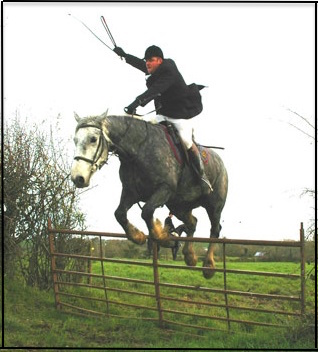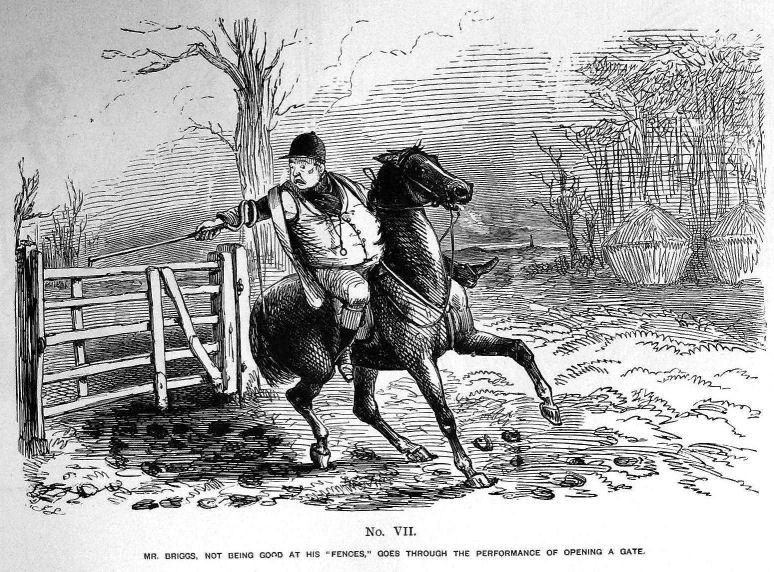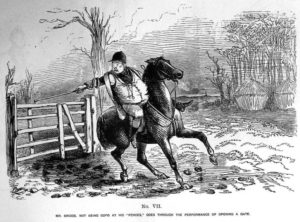For many of us following hounds, the need to open and close gates is a practical reality. While especially applicable to second field hunters, the jumping field isn’t always immune to this impediment. Nor is this a relatively new development, an indication that today’s foxhunters are not as bold as those of yesteryear.
The comic novels of R.S. Surtees and the sketches of his illustrator John Leech bear this out. The caption for the accompanying Leech sketch, published in 1850 in the satirical magazine Punch, reads, “Mr. Briggs, not being good at his ‘fences,’ goes through the performance of opening a gate.”
What might seem a simple task to some—you open a gate, go through it, then close it—can pose multiple complications when you factor in mounted riders, eager horses, and the mechanics of the gates themselves.
We consider here those variables.
Riders
When faced with gates in the hunt field, riders fall into three categories:
- Gate Getters
- Gate Attempters
- Gate Avoiders.
Gate Getters
A typical Gate Getter is one who can position a horse at the right spot to release the closure (chain, latch, etc.), open the gate enough for mounted riders to pass through safely, then shut and secure the gate. Sounds simple, right? It can be, until complications arise.
Such complications can include uncooperative horses, poorly hung gates, fiddly locks or latches, chains positioned too low to reach from horseback, etc. A competent Gate Getter can deal with most of those difficulties. And they are much-appreciated members to the club.
At the peak of this group you’ll find the Gate Getters Supreme, those who can do it all: Open gates from horseback (where possible), dismount to open the gate (where necessary), let everyone else pass through and go on their way while the Gate Getter’s horse waits patiently. The Gate Getter Supreme then remounts without drama, even if all others are well away, even out of sight.
Juniors are, of course, always handy to have around. Those limber joints and springy legs make hopping off and back on a breeze. But the juniors suffer from the nasty impediment of school attendance for most weekday hunts, which leaves the gate duty to those whose joints no longer have the bounce they once enjoyed—if, indeed, they have any bounce left at all.
For those who desire to bolster their status among fellow hunters, serving as a Gate Getter can provide a highly visible way to impress others (particularly those empowered to decide on the award of colors). This may sometimes lead to delays when the would-be Getter is more Attempter (see below). But some degree of recognition will be noted even if the attempt proves less than successful.
Gate Attempters
These folks are, speaking charitably, well-meaning folks. They may have a sincere desire to be helpful, but lack the ability to follow through. Or it may be that some Attempters and/or their horses just need more practice. All well and fine when the field is moving along at a leisurely pace and hounds are not running. But the capable Getters will rush forward with added vigor if they see a known Attempter making a move when the action is hot and there’s no time to dawdle.
Gate Avoiders
And then we have the Gate Avoiders. For whatever reason—lack of strength, a green horse, difficulty remounting, etc.—they remain silent and hold their place in the field while others deal with the gates. They are, though, mindful of their manners and offer a “Thank you” to the person who does perform the gate-getting duty as they pass through.
Gate Horses
It’s asking a lot of some horses to stand patiently next to a gate, positioned such that the rider can operate a latch or chain, which may take some fiddling. Even more cooperation is required for the horse to then assist with closing the gate. This can mean the horse has to move sideways to swing the gate into position and then stand again while the rider secures the closure.
Now let’s add to this the excitement of other horses moving off. Even if one or two helpful volunteers remain behind with the would-be Gate Getter, that still may not be enough to keep a herd-oriented animal calm. At a minimum, this might result in a slight delay in finishing the job and rejoining the field. In more extreme cases, it might lead to the call of “Loose horse!”
The Gates

And then there are the gates themselves as well as the gate closures. Ideally, the gate is hinged to swing easily, preferably both ways (sophomoric joke here optional) and to remain securely in place without the need to be held during the re-latching phase. Various failings to this ideal can occur.
For example, some gates refuse to remain politely in place while the Getter reattaches the latch. You think you’ve got it, you just need oooonnnne more second, and…swiiiinnnggg…there goes the gate, drifting away from your grasp. Teamwork can help here. A fellow Gate Getter comes to your aid and, with horse held steady hocks-to-hinges, keeps the misbehaving gate in place while you finish the latching job.
The flipside of this is the gate that won’t stay open as the riders attempt to pass through, requiring each one in turn to push the bloody thing aside and then utter an apology to the person behind as the gate flies back at him or her.
Some gates are hinged such that they won’t swing open at all of their own accord, instead resting so firmly on the ground that they have to be lifted upward and shuffled along bit by bit. If one can do this from horseback, one truly qualifies as a Gate Getter Supreme. Other gates are, literally, unhinged—nothing more than makeshift barriers propped up against rotting fence posts. Rather than swinging open, they’re more likely to topple over. These bad boys are the worst of all and not even the Supremest of the Supreme can handle them from the saddle. A group effort is most likely required.
Finally, we address the issue of gate closures. To be sure, most of the gates one encounters in the hunt field are there for a highly functional purpose—restraining livestock. (Where landowners are concerned about trespassing, some gates are kept locked, which adds an additional element of complexity.) However, most closures don’t have to be so complex that it takes a degree in mechanical engineering, the flexibility of an Olympic gymnast, and the strength of a Swarzenegger to open the darn things. A simple chain looped over a reasonably tall gatepost will, in most instances, do the job quite well. This eliminates the need for a rider to face the challenge of opening and then closing an uncooperative fastener, trying to prevent a loose chain from dropping to the ground, or dealing with a closure positioned so low one assumes the farm is managed by Munchkins.
That said, any gate-related inconveniences, whether minor or major, are more than offset by the privilege landowners extend in allowing us to hunt across their properties. Better for them to sleep well at night without worrying about their livestock than for us to make a fuss about fiddly gates.
As for you Gate Getters, whatever your skill level, take heart that you are part of a time-honored and essential tradition within our sport. As long as there are gates in the hunt field, someone has to get them. And, as he passes through in spirit, Mr. Briggs will surely tip his cap and thank you.
(A variation of this article originally appeared in the Winter 2017 issue of In & Around Horse Country.)




